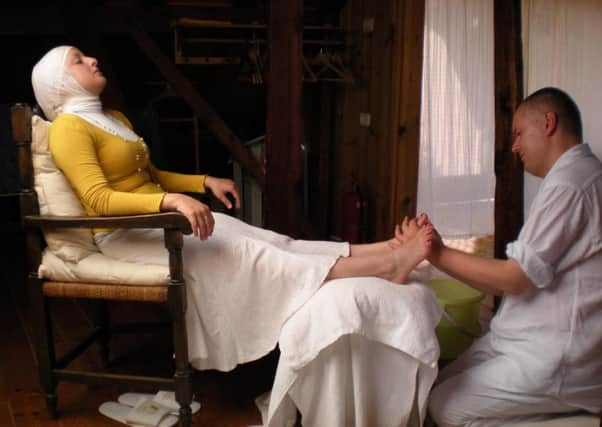Theatre: The rich legacy of performance artist Adrian Howells


Like all of Howells’ work, the event raised questions about whether it was really performance at all, or some new kind of encounter; a one-to-one meeting between audience and artist that involved being bathed, wrapped, held and plied with small bites of something delicious, in an almost magical counterbalance to the rush, harshness and frequent loneliness of life in a 21st century city. For Howells, challenging that loneliness, that lack of deep human connection, was a life’s work, particularly after he found his voice as a solo theatre artist in the early 2000s; and for anyone who experienced his work, to see that image now is to be assailed with sense-memories of a man and an artist who constantly made himself vulnerable in order to allow other people to show their vulnerability, and whose boundless softness and generosity of touch was felt by thousands, in the years between his first solo performance, in London in 2001, and his death, after a life-long struggle with depression, in March 2014.
My own first encounter with Howells came not in Edinburgh but in Glasgow, in the basement of the Arches in the autumn of 2003. At this stage of his career, Howells was performing in the persona of Adrienne, a heavily-made-up domestic worker in a nylon overall who, from show to show, tangled with tasks that included laundry, tea-making, hairdressing, and various forms of physical and emotional care work; and in 2003, he was performing a show called Adrienne’s Dirty Laundry, in a brightly-lit basement room fitted out in his own inimitable kitsch domestic style, all fairy lights and mementoes, some of them culled from his own 1960s childhood in suburban Kent.
Advertisement
Hide AdThe instruction was to bring something to be washed; everyone else had brought a tasteful T-shirt, but for some reason I had been inspired to bring some black lace underwear. And from that moment, I like to think, a bond was formed, as Howells gleefully labelled my stuff “Joyce’s lacy under crackers”, while luring his small audience into ever-more intimate revelations about their life and times, as the machine churned and spun; although in truth, one of Howells’ gifts was to form that bond with every audience member he encountered, never forgetting a name or a story.
And it was in Glasgow, too, that I first experienced Howells’ wonderful 2008 show Foot Washing For The Sole, a one-to-one experience that became perhaps the most famous of all his works, using the near-universal
ritual of washing another’s feet – present in nearly all major faiths – to create a moment of 21st century meditation to which people responded everywhere, from Glasgow and Edinburgh to Tokyo, Toronto and Tel Aviv.
There was something about encountering Adrian Howells on the Fringe, though, that made those who cared about his work especially aware of the strength and courage he exercised, in refusing to be drawn into the intensely rushed and competitive ethos of the western world’s biggest and most frenetic arts festival, and holding a space for something more gentle, more meditative and nurturing. In 2007, his Audience With Adrienne at the Reid Medical School – a session in which an audience of 12 or so, sitting around a living room space, was asked to choose the direction of the evening by telling their own stories, or selecting the ones they wanted to hear from Adrienne – was a huge Fringe success; and then in 2011 came that last, very close Edinburgh encounter with Adrian, when – moving on from the Adrienne persona – he created a space, in The Pleasure Of Being, where adults could, for an hour or so, feel as cherished, as safe, and as fully accepted, as the most beloved baby or toddler.
In a British Council video made in 2010, Howells talked about how he hated the amount of bad feeling about themselves that people routinely carry through adult life. He said that he was trying to create some kind of collective catharsis, maybe even a global catharsis – although he laughed at that last thought; it’s tempting to conclude that the kind of catharsis he tried to engineer was vastly preferable to the explosions of violence we now almost take for granted, worldwide, as expressions of long-suppressed pain and rage.
And whatever questions Howells’ work raised – about 21st century “performance”, about the power of one-to-one encounters to challenge the individualism of our time, and, for critics like me, about how such work can ever reasonably be assessed or criticised – Heddon and Johnson’s fine book certainly makes it clear, through its collection of academic essays, records, memories and tributes, that his influence is still reverberating through the world of performance, in Glasgow and beyond; not because his work was ever of the kind that could attract an audience of thousands in a single night, but because for those who did experience it, its imprint and its ripple effect was huge, and sometimes completely transforming. ■
It’s All Allowed: The Performances of Adrian Howells is published by the Live Art Development Agency and Intellect Books, www.intellectbooks.co.uk